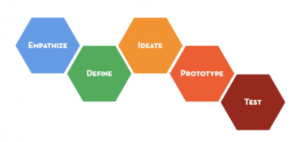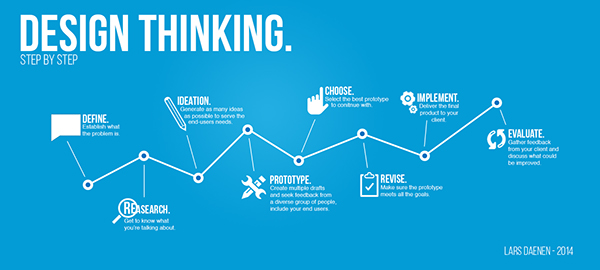Design thinking is a process ideal for generating insights about human problems in order to create innovative approaches to address those issues. While a traditional scientific approach to problems requires a clearly defined problem to analyze and address, design thinking encourages a more iterative approach that synthesizes insights to develop solutions that are “good enough for now” and that can be starting points for continued innovation. Design thinkers start with a goal in mind (make life better for those in poverty in our community) rather than a problem to solve (eliminate poverty) because problems, especially “wicked problems,” can have many potential causes and effects that can be approached from a variety of different angles.
Useful Design Thinking Language
 Formalized by the Hasso Plattner School of Design at Stanford University (commonly known as the d.school), their vision of the design thinking process has five stages that are continuously repeated during development: Empathize, Define, Ideate, Prototype, and Test. Using a “fail fast, fail forward” mindset, design thinking allows groups to try out multiple ideas/approaches as early as possible in the design process to see what works for real users rather than investing all capital into one idea that might not ultimately be the most effective.
Formalized by the Hasso Plattner School of Design at Stanford University (commonly known as the d.school), their vision of the design thinking process has five stages that are continuously repeated during development: Empathize, Define, Ideate, Prototype, and Test. Using a “fail fast, fail forward” mindset, design thinking allows groups to try out multiple ideas/approaches as early as possible in the design process to see what works for real users rather than investing all capital into one idea that might not ultimately be the most effective.
- Empathize – To empathize is to truly understand how an issue or reality impacts another person. A core stage in the design thinking process, we gain empathy through exploratory interviews with people affected, by shadowing them in their real lives, or by recreating conditions experienced by those people to better understand their perspective (e.g. living on $2 a day to understand poverty, or taping your joints to understand what it feels like to have arthritis). Empathy requires active listening and rapport-building for a deep understanding that can transcend innate personal bias or preconceived notions.
- Define – The second stage of the design thinking process asks “designers” to synthesize the information collected during the empathize phase in order to identify insights about the problem or issue being considered. While designers might have an idea what the issue is before the empathy phase, the design thinking process encourages them to “deep dive” during the empathy phase to generate true insights that might have been overlooked if the problem was defined before the research began.
- Ideate – To ideate is to generate a stream of ideas over a concentrated period of time; ideas can be good, bad, and everything in between but should build on the ideas of others in the conversation. Brainstorming is the most common form of ideation, but many other strategies exist. A good ideation session includes a diverse group of people with different perspectives and interests.
- Prototype – Prototyping involves creating a low-stakes manifestation of an idea to share with others for feedback, essentially a rough draft or minimal viable product (MVP). Prototypes might take the form of a drawing, storyboard, blueprint/outline, video, mock-up, model, or role play (for a process), for example. Creating the prototype helps the designer think through the idea and helps the audience understand and provide feedback on the idea.
- Test – In this last phase of the iteration, the designer introduces the prototype to stakeholders and constituents to generate specific and robust feedback . The testing process includes various methods such as A/B version testing, user interviews, focus groups, direct and indirect observation, and user feedback to guide the next iteration of a product or service.
Adaptable Language
Design thinking processes may be readily adapted to particular disciplines. The yellow example was created by IDEO, essentially the professional product and service design firm that spun out of the d.school. This version of design thinking uses slightly different terms but the key ideas are the same.
This blue graphic articulates steps that are inherent in the d.school’s five step process but breaks it down a bit further. Remember that design thinking is an iterative process. At any time you could decide to go back to another stage of the process if necessary to best explore your challenge and solution.
Iterate. Iterate. Iterate.
Iteration is a process that designers use to create multiple new or enhanced versions of a product, idea, or service based on observation from previous versions of that product or its prototype. Each version is prototyped, tested with a real stakeholder audience, and refined based on that feedback. Iterative design, in contrast to a more typical top-down project management/development approach, may occur numerous times during the development process until a product is ready to be released to a larger audience.
Check out how one consulting firm used design thinking to build a product to help get kids more active:
Social Innovation
Social Innovation, as defined by the Stanford Center for Social Innovation, “is a novel solution to a social problem that is more effective, efficient, sustainable, or just than current solutions. The value created accrues primarily to society rather than to private individuals.” Social innovation is a broader term than social entrepreneurship or social ventures which may focus more on socially conscious profit-making than directly addressing and making sustained change to a social problem. Social innovation is also different that service learning, thought the two approaches share DNA. While service learning might be more project-based and constrained by the limits of the course, social innovation initiatives are usually broader and ongoing, but a service learning project can certainly contribute to the work of a social innovation initiative.
Check out this short video about being a student changemaker:
Additional Terms
Social Innovation Lab/Studio – an organized collective of people from across sectors, fields, and socio-economic markers collaborating to create social change through design thinking and social innovation processes. The word “lab” does not mean science laboratory in this sense, but instead “incubator” or “collaboratory.” Most labs focus on a particular issue but recognize that most social problems are inextricably connected to other problems as well.
Divergent Thinking – A stage of the ideation process where participants generate many ideas and options without judging or eliminating any one idea. This type of thinking uses several brainstorming exercises and a combination of structured and free-form methods, the improvisation method of “yes, and…” to promote idea building as opposed to negation, sketching, and more. Divergent thinking often takes place before convergent thinking and may be repeated several times during project development.
 Convergent Thinking – Typically, the follow-up phase to divergent thinking wherein ideas are evaluated, consolidated, and placed into relationship with one another. Ideas are then combined and pruned to eliminate inappropriate or unfeasible options. Techniques such as ranking, card sorting, and star rating systems may be used to narrow the scope of ideas. The remaining ideas are reduced into a selection of concepts for prototyping and testing. This process may be revisited at any time in the process to make sure prototypes match design intent and approach the problem from the proper perspective.
Convergent Thinking – Typically, the follow-up phase to divergent thinking wherein ideas are evaluated, consolidated, and placed into relationship with one another. Ideas are then combined and pruned to eliminate inappropriate or unfeasible options. Techniques such as ranking, card sorting, and star rating systems may be used to narrow the scope of ideas. The remaining ideas are reduced into a selection of concepts for prototyping and testing. This process may be revisited at any time in the process to make sure prototypes match design intent and approach the problem from the proper perspective.
Give Design Thinking a Try!
Want to try on the design thinking approach right now? Check out this one hour design thinking boot camp by the Stanford d.school. Be ready to think creatively and build something fast!


